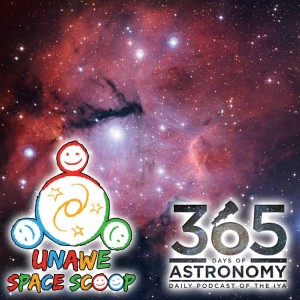Podcaster: Richard Drumm
Title: Space Scoop: Cosmic Cloud Seen From Highest and Driest Place on Earth
Organization: Astrosphere New Media
Link : astrosphere.org ; http://unawe.org/kids/unawe1426/
Description: Space scoop, news for children.
Bio: Richard Drumm is President of the Charlottesville Astronomical Society and President of 3D – Drumm Digital Design, a video production company with clients such as Kodak, Xerox and GlaxoSmithKline Pharmaceuticals. He was an observer with the UVa Parallax Program at McCormick Observatory in 1981 & 1982. He has found that his greatest passion in life is public outreach astronomy and he pursues it at every opportunity.
Today’s sponsor: This episode of “365 Days of Astronomy” is sponsored by — no one. We still need sponsors for many days in 2013, so please consider sponsoring a day or two. Just click on the “Donate” button on the lower left side of this webpage, or contact us at signup@365daysofastronomy.org.
Transcript:
This is 365 Days of Astronomy. Today we bring you a new episode in our Space Scoop series. This show is produced in collaboration with Universe Awareness, a program that strives to inspire every child with our wonderful cosmos.
Today’s story is…
Cosmic Cloud Seen From Highest and Driest Place on Earth
Some photographs are just too good not to share – this happens quite often when taking pictures of deep space. Consider the stunning new picture from the European Southern Observatory as an example. The photograph in this episode’s album art shows a little-known cloud of cosmic gas and dust (known as a nebula) called Gum 15.
This picture was acqured using a large telescope based in one of the most extreme environments on Earth; a very dry and a very remote region of Chile called the Atacama Desert. The area is so barren that it’s often compared to the surface of Mars. Scientists even ran tests there that were later used on Mars landers to look for life – and they didn’t find anything!
Although all that makes the Atacama Desert sound uninviting, it’s the ideal location for a telescope. With so little water, there’s hardly any chance of clouds gathering and blanketing the night sky. There are no towns, cities or even houses nearby, which means there is no light pollution contaminating images and no radio signals interfering with radio telescope observations.
And finally, the Atacama Desert is really high up, with much of it reaching 2,500 metres above seal level! It’s the closest thing to space! The higher a telescope is based, the less atmosphere it has to look through to see the stars. The atmosphere can distort and scatter light as it travels from space to the telescope. It’s what makes the stars twinkle after all!
Thanks to the combination of all these things, telescopes based in locations like the barren Atacama Desert can capture beautifully detailed images of the Universe, like this one!
Here’s a Cool Fact
Cosmic clouds like Gum 15 produce many thousands of stars over a period of several million years!
Thank you for listening to 365 Days of Astronomy!
Thank you for listening to 365 Days of Astronomy!
–––––––––––––––––––––––––––––––––––––––––
365 Days of Astronomy is a community podcast made possible thanks to the contributions of people like you. Please consider donating at 365DaysofAstronomy.org/Donate
End of podcast:
365 Days of Astronomy
=====================
The 365 Days of Astronomy Podcast is produced by Astrosphere New Media. Audio post-production by Richard Drumm. Bandwidth donated by libsyn.com and wizzard media. You may reproduce and distribute this audio for non-commercial purposes. Please consider supporting the podcast with a few dollars (or Euros!). Visit us on the web at 365DaysOfAstronomy.org or email us at info@365DaysOfAstronomy.org. In the new year the 365 Days of Astronomy project will be something different than before….Until then…goodbye


